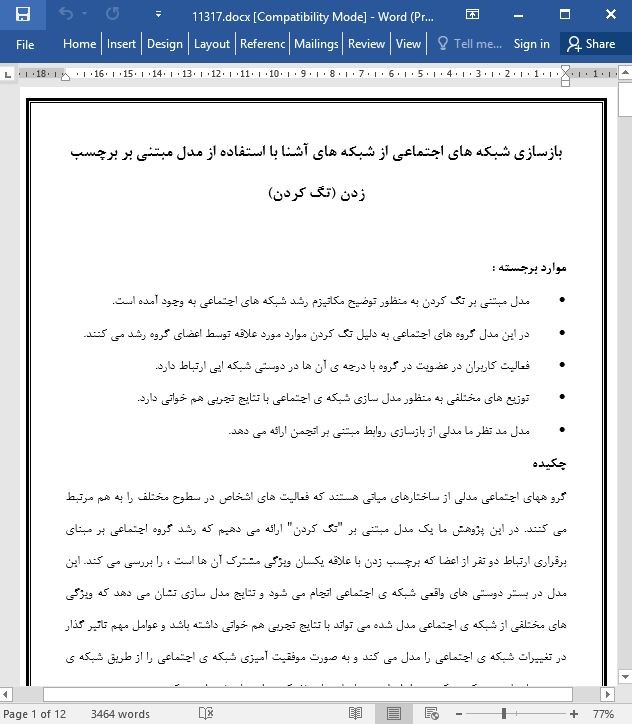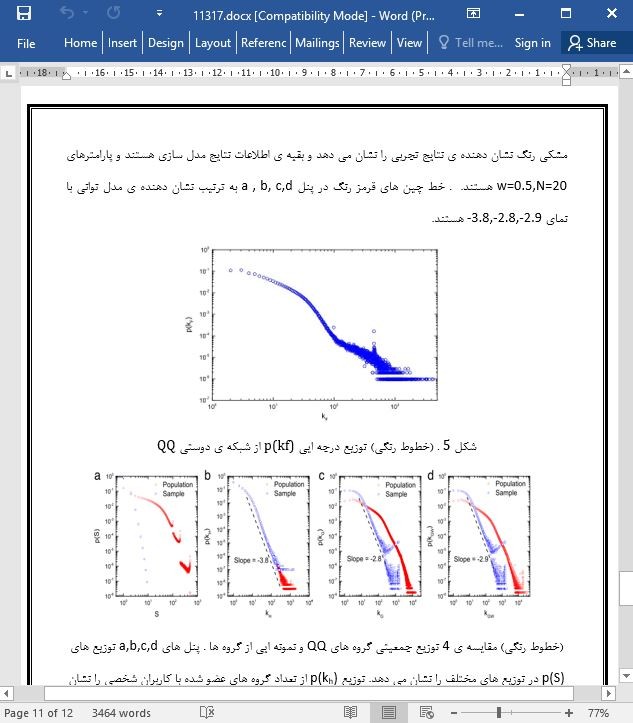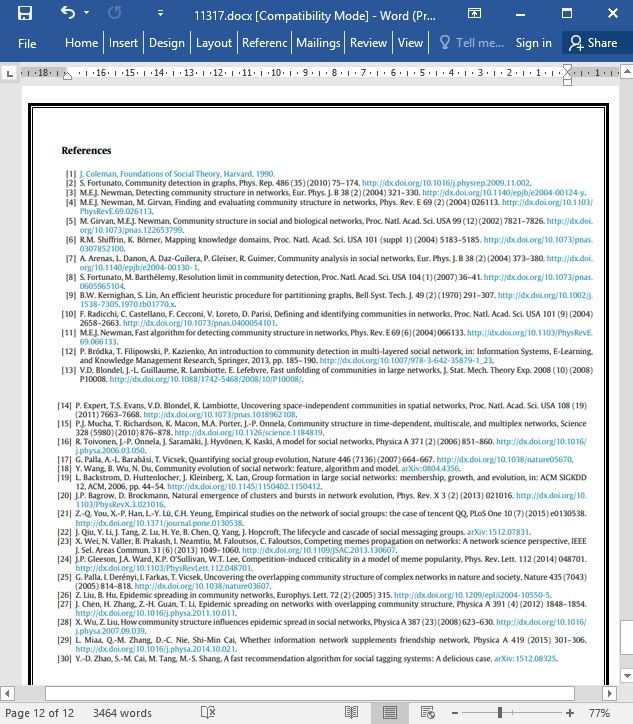
بازسازی شبکه های اجتماعی از شبکه های آشنا با استفاده از مدل مبتنی بر برچسب زدن
چکیده
گرو ههای اجتماعی مدلی از ساختارهای میانی هستند که فعالیت های اشخاص در سطوح مختلف را به هم مرتبط می کنند. در این پژوهش ما یک مدل مبتنی بر "تگ کردن" ارائه می دهیم که رشد گروه اجتماعی بر مبنای برقراری ارتباط دو نفر از اعضا که برچسب زدن با علاقه یکسان ویژگی مشترک آن ها است ، را بررسی می کند. این مدل در بستر دوستی های واقعی شبکه ی اجتماعی انجام می شود و نتایج مدل سازی نشان می دهد که ویژگی های مختلفی از شبکه ی اجتماعی مدل شده می تواند با نتایج تجربی هم خوانی داشته باشد و عوامل مهم تاثیر گذار در تغییرات شبکه ی اجتماعی را مدل می کند و به صورت موفقیت آمیزی شبکه ی اجتماعی را از طریق شبکه ی دوستی بازسازی می کند و کنش روابط را بین سازمان های (شبکه ی اجتماعی) مدل می کند.
1. مقدمه
اجتماعات گروه ها در جوامع مختلف شامل فرهنگ ها ی مختلفی و در دوره های زمانی متفاوتی اتفاق افتاده است. این اجتماعات می تواند شامل افراد در انجمن ها ، سازمان ها و فدراسیون های مختلف باشد و معمولا افراد پایداری هستند که تگ کردن را در این گروه های اجتماعی انجام می دهند. در این پژوهش این نمونه از انجمن های اجتماعی را "گروه اجتماعی می نامیم" . به طور کلی تفاوت های بین ساختار های مطلق را اجتماع می نامند ، گروه اجتماعی به دلیل مزرهای مشخصش ، نمونه ی ساختار میانی آشکار از این جامعه است. از آن جایی که این تگ کردن برآمده از انجمن / سازمان ها است ، گروه های اجتماعی تطابق قابل قبولی با این انجمن / سازمان ها دارد. این هم بستگی راه های ممکن به منظور بررسی روابط بین انجمن های حقیقی و اطلاعات مربوط به جوامع آنلاین را فراهم می کند. از گروه های آنلاین به عنوان محلی به منظور ارائه ی اطلاعات و بحث های عمومی استفاده می شود در نتیجه این گروه ها نقش موثری در پیشرفت اطلاعاتی و اشتراک گذاری عقاید دارند.
4. بحث
هسته اصلی این مدل ارائه شده این فرضیه است که، کاربران فعال امکانات بیشتری برای پیوستن به گروه داشته باشند و هر کاربر در شبکه ی دوستی تعدادی تگ مورد علاقه بیشتر یا کمتر دارد و آن ها گروه هایی را با تگ هایی که انجام شده است ، به وجود خواهند آورد و یا در آن عضو خواهند شد. به عنوان یک مدل حداقل ، نادیده گرفتن چندین مورد واقع بینانه که کاربران از گروه خارج می شوند و یا گروه ها از دسترس خارج شوند فرضی برای شرایط اضطراری است. با این حال برای انجام این کار ، این مدل پارامتر های بیشتری را ارئه می دهد و نتایج پایه می تواند به صورت زیر باشد:تمایل یک فرد برای عضویت در یک گروه نه تنها متاثر از تگ های انجام شده است بلکه مهتر از آن متاثر از شراییط محیطی اطراف کاربر است. فرضیه اصلی از این مدل با قوام بالا بین نتایج شبیه سازی و یافته های تجربی تأیید شده است. این مکانیزم یک بینش اکتشافی به درک ظهور و رشد گروه های اجتماعی و بازسازی شبکه گروه اجتماعی فراهم می کند .
Abstract
Social group is a type of mesoscopic structure that connects human individuals in microscopic level and the global structure of society. In this paper, we propose a tag-based model considering that social groups expand along the edge that connects two neighbors with a similar tag of interest. The model runs on a real-world friendship network, and its simulation results show that various properties of simulated group network can well fit the empirical analysis on real-world social groups, indicating that the model catches the major mechanism driving the evolution of social groups and successfully reconstructs the social group network from a friendship network and throws light on digging of relationships between social functional organizations.
1. Introduction
Gathering groups is widespread in societies covering different cultures and different historical periods [1]. Human individuals form associations, organizations and institutions, and there are usually relatively stable members, clear social tags and boundaries in each of these social institutes. In this paper, this type of social institutes is termed as ‘‘social groups’’. Generally, different from the widely-discussed implicit structure termed as ‘‘community’’ [2,3], social group is a type of explicit mesoscopic structure of society because of their clear tags and boundaries. Since these tags usually come from the real-world social functional institutes/organizations, social groups will have strong coincidence with these social institutes/organizations. For example, a user usually would like to join a group whose major members are his/her colleagues or teammates. This correlation actually provides a possible way to investigate the relationships and effective organizations between real-world functional institutes from the group information of online societies. And also, online groups usually are widely used to be a place for information releasing and public discussing, and they therefore play an important role in the spreading of online information and the formation of public opinions.
4. Discussions
The core of the proposed model is the hypothesis that, active users will have more possibilities to join groups, and every user in the friendship network has some tags of interest more or less, and they will create or join groups within their tags of interest. As a minimum model, neglecting several realistic cases that users possibly withdraw from groups, or groups can be dismissed is inevitably only an approximation for the process of real emergence. Nonetheless, to do this would introduce more parameters and cloud the basic result: the tendency of an individual to join a group is not only influenced by its tags of interest, but also crucially related to its current external state in the social environment. The basic hypothesis of the model is verified by the high consistency between the simulation results and the empirical findings. This mechanism provides a heuristic insight to the understanding for both the emergence and the growth of social groups and the reconstruction of social group network from friendship network.
چکیده
1. مقدمه
2. مدل ارائه شده
3. نتایج مدل سازی
4. بحث
Abstract
1. Introduction
2. The model
3. Modeling results
4. Discussions
- ترجمه فارسی مقاله با فرمت ورد (word) با قابلیت ویرایش، بدون آرم سایت ای ترجمه
- ترجمه فارسی مقاله با فرمت pdf، بدون آرم سایت ای ترجمه



